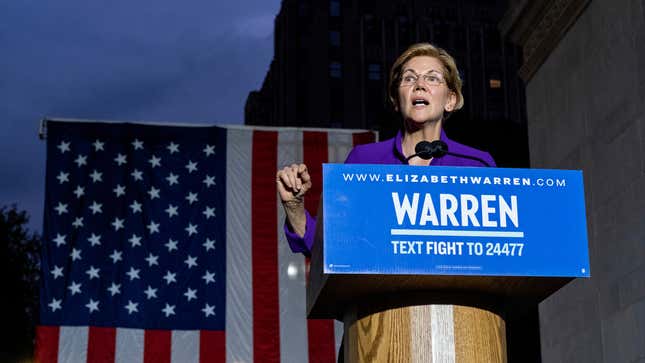

NEW YORK—On Monday evening, Elizabeth Warren stood in front of Washington Square Park’s floodlit arches for what was certainly her largest campaign rally to date: the campaign put the crowd at 20,000, though of course, campaigns tend to inflate. “We’re not here today because of famous arches or famous men,” the Massachusetts Senator said. “In fact, we’re not here because of men at all—we’re here because of some hard-working women.”
The choreography of the event, in which Warren deviated from her usual speech about her upbringing to tell a story that invoked the systemic change brought by the Triangle Shirtwaist fire of 1911, was intended to showcase the presidential candidate’s anti-corruption platform, as well as a recent endorsement from the Working Families Party. Both had been announced earlier that day. In the warm-up before Warren took the stage, her campaign manager instructed attendees to introduce themselves to each other: a middle-aged woman standing near me and a guy wearing an aqua workout shirt printed with the word “Obama” on every conceivable surface had a quick chat. “Were you here for the Bernie rally in 2016?” one asked. (Naturally, she was.)
Invoking the most grassroots of activist campaigns during a presidential run is always sort of weird. Every candidate does it to some extent, but it’s just bizarre to look at someone running for president—the most phony, expensive, and crowd-tested of any political enterprise—and connect it back to something that seems to grow out of the exact opposite impulse. Still, Maurice Mitchell, the national director of the Working Families Party, introduced Warren by talking about the Movement for Black Lives, and saying Warren “laid the groundwork for Occupy Wall Street,” both nebulous, leaderless movements, but which in Mitchell’s estimation happened when “institutions went too far.”
The symbolism of the night was intentionally thick: Warren spoke from a podium that, I had been told, was built by a bespoke Brooklyn builder (a supporter) out of wood salvaged from labor hero Frances Perkins’ homestead. The podium stood 46 inches tall—for the 46th president of the United States—and was inscribed with messages of support. The crowd chanted “this is what democracy looks like,” which it very well might some day but doesn’t right now.
Warren spoke at length about Perkins: after watching more than a hundred workers—most of them immigrant women—die in the Triangle Shirtwaist Factory fire, Perkins intensified her lobbying efforts and took a number of positions within city and state government to secure safety measures for workers. She eventually became the Secretary of Labor for Franklin D. Roosevelt. At one point, Warren described the activist as a “persistent woman” a call-back to the candidate’s one-time campaign slogan. Like Warren, the speech inferred, Perkins was successful in creating “big systemic change.”
Warren’s anti-corruption platform, which she had published as a Medium piece earlier that day, intends to “end lobbying as we know it,” placing hard limits on who politicians are allowed to work and consult for after they leave office, and making every meeting between a lobbyist and a public servant a matter of public record. She also spoke in some detail about her wealth tax. Supporters chanted “two cents on the dollar” from close to the stage—one of Warren’s many plans involves taxing wealth over $50 million by that amount.
From her hand-crafted, excruciatingly symbolic podium, she spoke of all the things Americans could—and should—do with that money: universal pre-k, universal child care, better wages for childcare workers, tuition-free college, cancelling student debt, pouring money into historically black colleges. I found myself begrudgingly moved by all of this, as cynical as moments like these are, and as much as I’m generally disinclined to believe a word that’s said on the campaign trail.
Warren’s various plans would require a near-total dismemberment of the structures on which our politics have been built in my lifetime—which Warren herself is occasionally loathe to admit—and reorienting such a massive amount of money would doubtlessly make our country a better and more equitable place. Warren, like Sanders, is allying herself with social movements to build power and credibility on her way to the least movement-oriented office in America. Running for president as a progressive, dependent as it is on these mass movements, is still maybe the most singular, least natural thing a person can do.
Which is the contradiction of it all: if either Warren or Sanders does win the presidency, those people who elected them will, in many ways, necessarily become their adversaries as the candidates conform to the presidency and, as always, break promises. That’s how movements work: to apply and keep pressure on powerful institutions. I’m aware this isn’t the sort of takeaway a person is supposed to have during a rally for a candidate still barely in third place for the Democratic nomination. But events like this, with their very specific choreographies and metaphors designed to draw connections over hundreds of years of history, only ever remind me that even the candidates offering my preferred sets of policies are putting on a calibrated show.